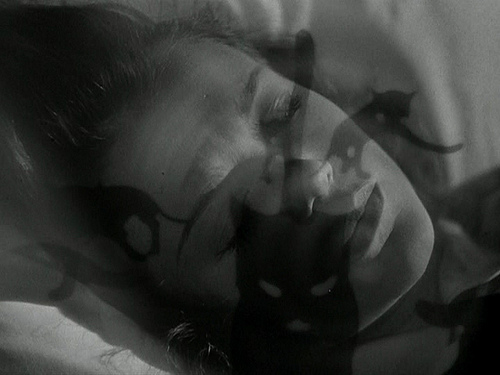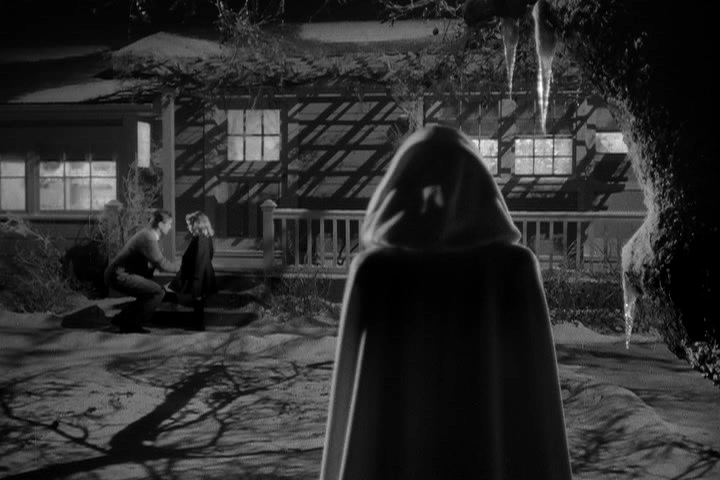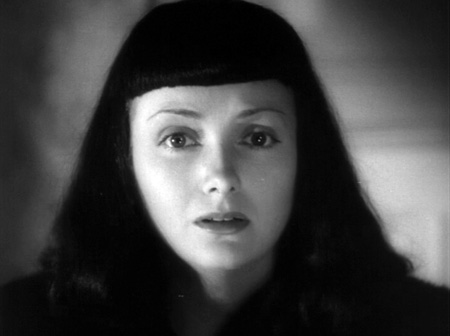The Dissolve commentariat has been posting write-ups of horror movies all month (which are amazing and which you should read). Here’s mine, on Val Lewton.
SCAREFEST: Val Lewton Marathon — Cat People (Jacques Tourneur, 1942); The Curse of the Cat People (Gunther von Fritsch, Robert Wise, 1944); The 7th Victim (Mark Robson, 1943)
The original Cat People – Val Lewton’s 1942 production debut for RKO, directed by Jacques Tourneur – is justifiably famous for the absence of, well, cat people. On screen, anyway. The movie operates in shadows and insinuation, mood and dream-logic. But while the plot definitely revolves around cat people, no scary cat-person ever shows up, exactly. This was the product of necessity: there was no money for stars or costumes or effects, so monster-movie scares had to be generated without the monsters. Lewton and Tourneur delivered, through legitimate craftsmanship and two crucial insights – sometimes the creepiest thing is just out of the frame, and dread can be as effective as fright for drawing an audience.
Its nominal sequel, The Curse of the Cat People, simply dispenses with the cat people altogether. It’s a strange and surprisingly moving film, and doesn’t really register as a “horror movie” at all, despite drawing on Sleepy Hollow, creepy imaginary friends, and featuring a little kid going into an old spooky house where a weird lady lives. Whether or not it’s a horror movie per se, you’ll still notice one item missing from that list. (It’s cat people.)
What the two movies definitely share, along with 1943’s The 7th Victim (also produced by Lewton for RKO), is the mood. There’s a sense that something is off; that while everything being shown and spoken is clear and understandable enough, there’s still something just below the surface threatening to rise. Compared to the classic monster films Universal was putting out at the time – and which led RKO to launch their production in the first place, hoping to cash in – these are bizarre experiences, more lo-fi David Lynch noir than creature-feature.
 In Cat People, Irena (French actress Simone Simon) draws pictures of panthers at the zoo, and surrounds herself with cat totems from her hometown in Serbia. Oliver, the man she meets and marries (but never once kisses, afraid of a prophecy that says her desire will unleash the animal inside), is an architect obsessed with boats. At dinner in a restaurant, a strange woman approaches, cloaked in furs, and addresses Irena as “sister,” before promptly leaving. (Roger Ebert’s excellent review finds a queer subtext in this exchange.) When Oliver’s co-worker Alice (the third point of their love triangle) is in danger from something unseen in the shadows, the street she runs along is simply a loop of the same brick wall, with the same lightpost again and again. She becomes frantic in fear of this invisible prowler, but is able to jump on a bus that shows up out of nowhere just in time, careening in from the right side of the screen in an early version of a fakeout jump scare. It plays extraordinarily like a bad dream.
In Cat People, Irena (French actress Simone Simon) draws pictures of panthers at the zoo, and surrounds herself with cat totems from her hometown in Serbia. Oliver, the man she meets and marries (but never once kisses, afraid of a prophecy that says her desire will unleash the animal inside), is an architect obsessed with boats. At dinner in a restaurant, a strange woman approaches, cloaked in furs, and addresses Irena as “sister,” before promptly leaving. (Roger Ebert’s excellent review finds a queer subtext in this exchange.) When Oliver’s co-worker Alice (the third point of their love triangle) is in danger from something unseen in the shadows, the street she runs along is simply a loop of the same brick wall, with the same lightpost again and again. She becomes frantic in fear of this invisible prowler, but is able to jump on a bus that shows up out of nowhere just in time, careening in from the right side of the screen in an early version of a fakeout jump scare. It plays extraordinarily like a bad dream.
In The Curse of the Cat People, the focus shifts to a young girl, the child of two characters from the previous film, who is either sensitive or troubled, and her anxieties, attempts to fit in and do right, and her alienation from her peers. There’s a bit of a Carrie prototype here … or would be, if the film chose to go in that direction. I’m still not sure what direction it does choose – those peers, for instance, are never heard from again after roughly 20 minutes – but the evocative shadows that became the Lewton hallmark are everywhere. And there’s the added creep factor of a child protagonist: she’s a tiny person on a huge set, the staircases and dark halls are forbidding, and the camera invariably is pointing up at the looming objects or down at the small girl with whom we identify. It’s unsettling, even if nothing much seems to happen.
Of course, nothing much does happen in many childhoods, more often than not, or at least not in the ways we think. Elaborate fears prove unjustified; you usually don’t get eaten by a monster in the dark. But that doesn’t make it any less scary at the time, or any less awful when no one believes that you might. The film effectively touches on the disbelief, casual skepticism, and patronizing allowances with which adults treat children, who are certain they saw something … in the closet, under the bed, or, in this case, out in the yard by the swing.
As it turns out, the ghost lurking there in The Curse of The Cat People is more a protector from the living than a threat from beyond the grave, but what’s scary in the film is the child’s helplessness and total lack of power in a much bigger world. And her inability to explain herself, avoid misunderstanding, even when being completely honest and direct. The cat people’s curse, held over from the first film, might just be the way no one will listen to you about the presences, dangerous or otherwise, that you sense. The curse is awareness of the supernatural in a world predicated on its repression.
The 7th Victim does not take place in this “Cat People minus cat people” world, although it’s kind of hard to tell if you watch all three in a row. This is especially true since Tom Conway keeps showing up, looking like Vincent Price, seeming deeply untrustworthy, and saying things like, “I prefer the left … the sinister side.” The film involves a missing sister in the big city, a curiously tolerated Satanic cult, a weird aside about evil beauty products, and a Rosemary’s Baby-esque meeting, except it’s more jury trial than baby shower. I actually don’t think much of this matters – once again, it’s the mood and the images. Particularly striking: a door is forced open and we expect something gruesome; instead it’s an empty room with a noose hanging from the ceiling above a chair. It’s a terrifying moment, and it cost exactly the price of a chair and a piece of rope to shoot. The 7th Victim’s meandering plot pays off with a brilliant, evocative, and rather disturbing ending, with the contrast of two characters, headed in different directions, going to the same place in the end.
The short documentary Shadows in the Dark: The Val Lewton Legacy points out that RKO simply handed Lewton the titles, and gave him the freedom to shoot a picture as he saw fit (although with barely any money, of course). That is, to use the technical term, fucking nuts. And even more amazing is that these idiosyncratic and sophisticated movies were the result.



